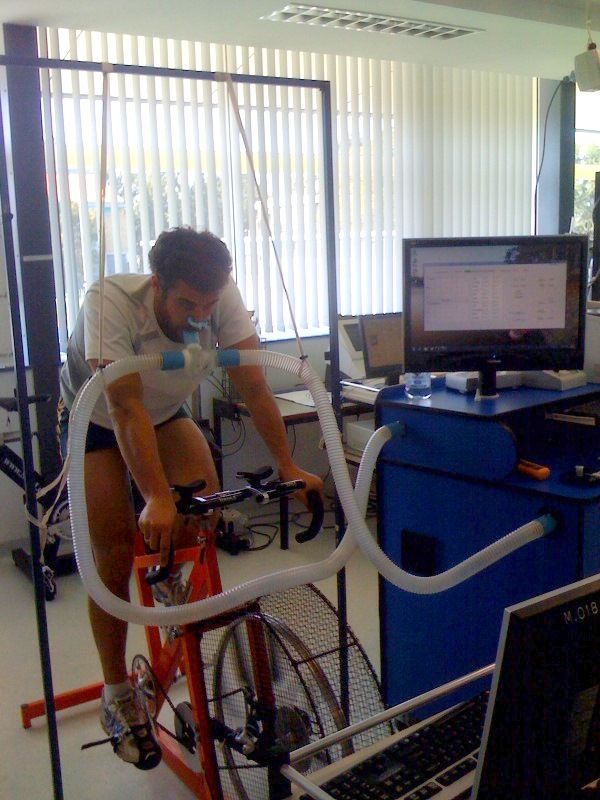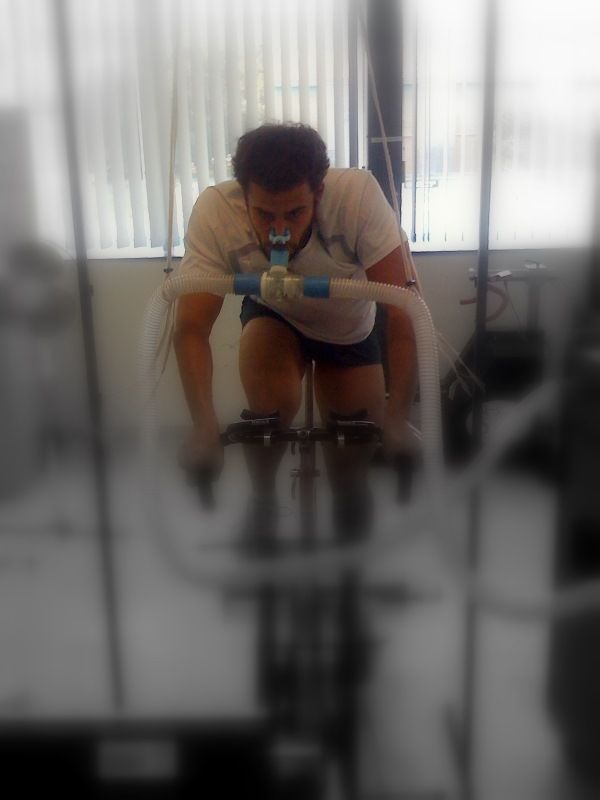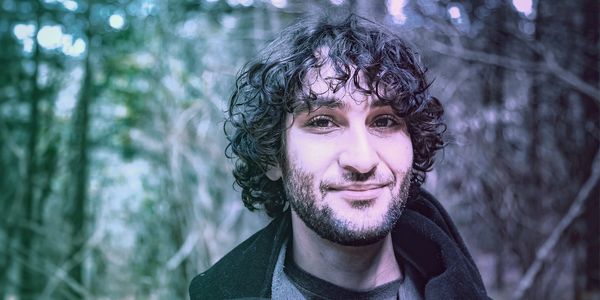Phil Drolet • • 8 min read
On Becoming Superhuman: Using Jedi Mind Tricks To Increase Performance

September 20, 2pm- University of Western Australia, Perth. I’m casually walking into the University’s Sports Science Lab. This is my first time in a sports lab, and I feel like I’m entering the scene of a Gatorade commercial…
I’m here to take a VO2Max test, which measures maximum aerobic capacity — an endurance athlete’s lifeblood. This test leaves no room to hide: it’s going to tell me straight up how fit I really am. I’m excited to give it a try, but I’m also quite nervous. According to my Dad, an accomplished endurance athlete and one of the toughest guys I know, VO2Max tests are “horrible, and they make you feel like a quitter.” What better way to spend a beautiful Tuesday afternoon? :) On the bright side, the lab has a nice view overlooking the campus’ outdoor pool, and the lab’s speakers are blaring good tunes. I’m digging this Feel Good set-up. The official reason I’m taking this test is because I’m volunteering to provide data for a research project on muscle fatigue.
The unofficial reason? I want to get some free data to help me evaluate some of the experiments I’ve been running in my own training.
Some Background Information
I’ve been training in endurance sports my whole life. I was a high-level swimmer, reaching the National Junior Team for Canada in 2005. Lately, I’ve been training for the Anaconda Adventure Race (13km trail run, 2km ocean swim, 13km ocean kayak, 32km mountain bike, 2.5km beach run). Because this race is more challenging than anything else I’ve ever done before, I’ve decided to step up my training a notch.
But not the traditional way, by training more or taking some crazy supplements. No- instead, I’ve started complementing my physical training with Eastern mindfulness techniques to strengthen my mind in addition to my body.
Endurance sports & spirituality… unlikely combination? Definitely. Effective? Well, we’re about to find out!
Here’s how the test works: Using a stationary bicycle, I have to pedal at a set intensity for 3 minutes, then increase by 25 watts to reach the next “level”. I change levels every 3 minutes until eventually I can’t generate the power required (or collapse). Nice & simple. I ask the researcher how long the test should take. She tells me, “about 15 minutes”. Short & sweet. Perfect. I get settled with the astronaut-like breathing tube, which will measure my oxygen intake as the intensity of my effort increases. I put on the “nose-pincher” to make sure that my oxygen intake will be adequately measured. Now I really feel like I’m in a Gatorade commercial!
Let’s do this!
The Test

All geared up and ready to go, I start at 125 Watts for 3 minutes, and work my way up from there. 150, 175, 200 Watts. The first 10 minutes are mellow, and I’m staying relaxed by listening to the 2 researchers share stories from their weekend. At the 12 minute mark, things start getting interesting. I’m generating 225W of power and pushing the pace a bit. I start sweating, and that’s when I know it’s time to deploy my Jedi Mind Tricks: a set of mental techniques I’ve gathered over the last few months through my daily practice of meditation and yoga, and which I’ve adapted to the context of high-intensity effort.
Jedi Mind Trick #1
is something I call active-relaxing meditation. The idea is to relax all the parts of my body that are not involved in the effort. In this case, while my legs are pedaling hard, the rest of my body is absolutely relaxed and tensionless. I achieve this by focusing on exhaling deeply while visualizing my body totally limber and loose. This trick ensures that no energy goes to waste.
Jedi Mind Trick #2
The ‘Breath of Giants’! On each breath, after I exhale, I inhale deeply, from my belly all the way to my upper chest, to maximize my air intake. As we learn in yoga and meditation, most humans naturally use poor breathing patterns (chances are you are breathing sub-optimally as you read this). This means that it’s our responsibility to learn how to breathe better. This is important for everyday life (to stay relaxed and focused), and when doing an aerobic sport such as cycling and running.
To get a glimpse of the power of optimal breathing, try this little experiment right now. Exhale out all the way, then breathe all the way in. Alllll the way in. A bit more, come on. All right, now, hold your breath for 10 seconds. Done? Now, breathe all the way out. Do this cycle 2 more times, and I guarantee you’ll already feel differently than you did a minute ago.
Jedi Mind Trick #3
Perhaps the most powerful one — a technique called stillpoint meditation. I fix my eyes and my mind on one point, focus all my attention on it, and forget everything else. This is how I use Zen power to get in the Zone! It allows me to turn off my mental chatter, and block off all distractions.
Some people relate this technique to going to their happy place, but for me it’s more like going to my “comfy” place. There’s no party or beautiful beach in my head, but it does shield me against against pain, fatigue, and negative thoughts.
These 3 Jedi Mind tricks really helped me crush the 30-Day Cold Shower Challenge, and now it’s time to put them to the test once more.
Back to 12 minutes… Jedi Mind Tricks loaded and ready to go. Even though the intensity of the effort is increasing, I start feeling increasingly chilled out as I get into the mental groove.
15 minutes: I’m zoning in & out, just keeping an eye on the computer screen to ensure my wattage is in the right range. But I’m super relaxed otherwise. This is kinda cool.
20 minutes: Things are going well and I’m breathing at the same rate as when I’m walking. Damnnn, this is totally working!
25 minutes: I’m working hard, but in my mind I’m chilling. The song Party Rock by LMFAO comes on, and I allow myself to throw a few fist pumps in the air.
30 minutes: I’m still going strong. But something strange happens: the machine stops. Uh oh. Confusion sets in, and it takes us a second to understand what going on… I’ve just beaten level 10, which is the software’s built-in limit. I can’t help it but giggle a bit and give myself a mental high five as I realize that I’ve beaten the machine!
The celebrations are short-lived as a few seconds later the researchers hit some buttons and the machine comes back roaring. This battle ain’t over yet. And it seems like the machine came back with a vengeance. I’m fighting to keep my breathing under control, and a few little negative thoughts are trying to creep in. Luckily, I’ve got my mental lightsaber and I destroy them as soon as their enter my consciousness.

36 minutes: We just cranked up the intensity to 400W. Things are hectic and I’m pedaling like a madman. The tube in my mouth makes it impossible to drink (or salivate) and my mouth is as dry as the Sahara.
38 minutes: My vision gets blurry. Not sure if it’s from the effort or from having sweat in my eyes. Probably both. This is getting ridiculous. Part of me wants to quit, but hell no, I’m at least going to finish Level 13.
39th minute: I’ve made it through Level 13, and as a reward, the machine increases its roar. I wants to finish me. I’m hurting like hell and seriously thinking of calling it quits any second now. But then, something magical happens. The researcher looks over at my performance data on the screen. She stops, incredulous, and tells her colleague in a slightly dramatic tone: “I’ve never seen anything like it before”. Hearing these words is like a dose of rocket fuel for my mind & body. F*ck this, I’m going to smash this level too. Time to show science what’s up!

The last 3 minutes are a blur. Halfway through the researchers ask if I want to stop. I grunt and shake my head. No way. Last minute. I throw the Jedi Mind Tricks out the window. At that point, it’s pure balls & French Canadian toughness. 10 seconds left. Final push!!! I crank it all the way up to 510 watts, which I later learned is the highest ever recorded at this Lab. I cross my mental finish line and stop after 42 minutes of excruciating effort. Woaaahhhh. So much for the short & sweet 15 minutes test!
I get off the bike, and start stumbling around the lab like a guy who’s just downed his 15th beer. My legs are not cooperating anymore. I can barely support myself. But suddenly, I get a massive rush of endorphins. Aaahhhh. Feelin’ good once again. I collapse on a couch and chill there for a while, a big ol’ smile beaming across my face.
The Results
The researcher walks over and congratulates me for scoring 61.4 (ml/kg/min), which ranks me in the upper range of the 99th percentile. To give you a point of reference, it’s higher than any Australian Football Player ever recorded, and almost any Hockey player. The crazy thing is, I’m not a full-time athlete by any stretch of the imagination, and I don’t train nearly as much as any of those guys. I workout 1 to 2.5 hours/day, I don’t have a coach, training partners, or even an organized training plan for that matter. I do whatever sport I feel like each day. But I do make sure to push hard and make each training count.
How Did I Do it?
Training is still a hobby, and I’m doing it for fun. Yet I’ve just achieved high-level performance on a grueling physical test. How’s that even possible? 3 main reasons: Superior nutrition, more effective training methods, and most importantly, Jedi Mind Tricks.
It’s simple. By practicing meditation, mindfulness, and developing optimal breathing, I can achieve greater performance with less effort. I have a stronger focus on the task at hand, I stay more relaxed, and I can step up my game when it counts.
While it’s the field of biogenetics that captures most of the attention with regards to human performance enhancement, I believe that Eastern mindfulness techniques represent an untaped gateway into “superhuman” performance.
And the best news in all this? It can help you even if you’re not an elite athlete, but simply someone looking to get fitter, look better, and have more energy. So why wait? If you want to get started on meditation, all you have to do is begin with 5 minutes/day. It can be first thing in the morning (which I do), during the day, or at night. But commit to doing it everyday, for at least 30 days. By the end of the month, it’ll have become a part of your daily routine, and you’ll already be feeling some of the benefits.
I’m coming on the first anniversary of my commitment to everyday meditation, and in all honestly I can tell you it’s one of the best decisions I’ve ever made. I know that for many Westerners, meditation is still this weird mystical concept. Something about sitting around with eyes closed, and a scene with Buddhist Monks in the Hangover 2.
But it’s not a bizarre or “woo-hoo” activity, but rather an effective and pleasant way to feel good, greatly improve our life… and maybe even become superhuman! :)










